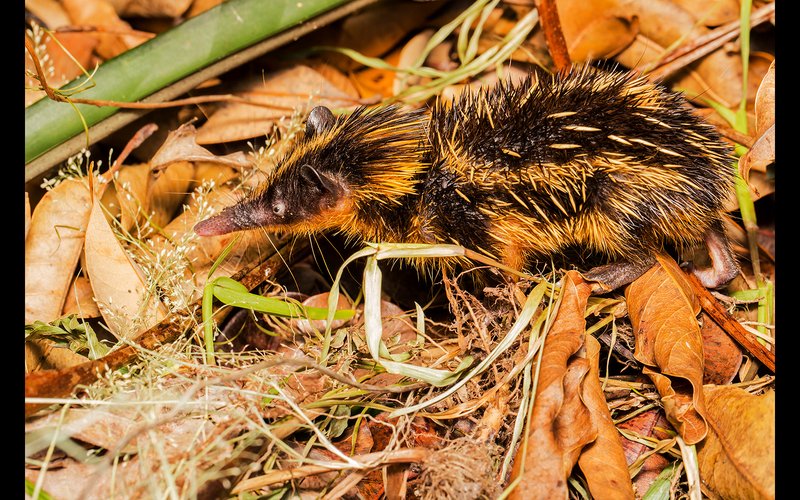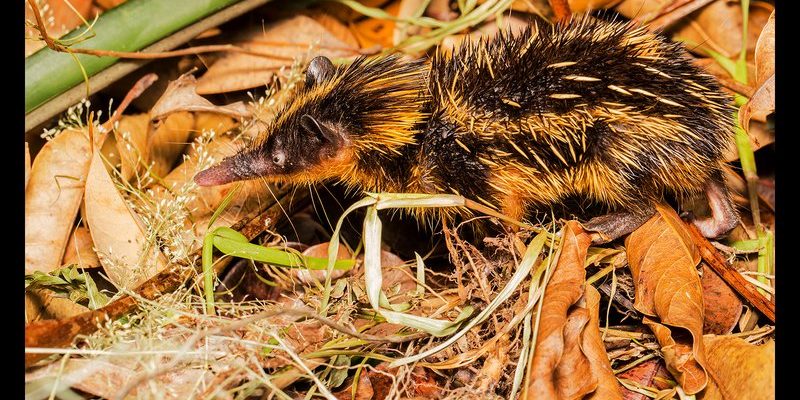
The Lowland Streaked Tenrec is like a living puzzle piece of Madagascar’s unique ecosystem. Imagine a small, spiky creature that blends the features of a hedgehog and a shrew, with a dash of charm thrown in. These intriguing animals live in tropical rainforests and bring a quirky flair to their surroundings. As you explore the world of the Lowland Streaked Tenrec, you’ll find that they’re not just cute faces—they play a significant role in their ecosystem.
But what exactly is a Lowland Streaked Tenrec? These small mammals are part of a group called tenrecs, which are unique to Madagascar. Known for their distinctive markings and charismatic behaviors, they live in various habitats across the island. If you’re new to the world of tenrecs, you might be surprised to learn about their fascinating adaptations and lifestyles.
Physical Characteristics
When you first spot a Lowland Streaked Tenrec, you might notice its most striking feature: its fur. This little creature is covered in bristles and has distinct streaks that run along its body, making it look like it has a fashion sense of its own! Typically, these tenrecs measure about 25 to 30 centimeters in length, with a weight that can range from 1 to 2 kilograms.
These animals have a somewhat elongated body, a pointed snout, and small, bright eyes that seem curious about the world around them. They rely on their keen sense of hearing and smell as they scurry through the underbrush in search of food. Their feet are equipped with sharp claws, which not only help them dig but also serve as tools for climbing and navigating through their varying habitats.
In many ways, their physical features help them adapt to the humid environments of Madagascar. The bristly fur not only provides warmth but also protects them from potential predators. This unique appearance makes them both a joy to observe and an essential part of their ecosystem.
Habitat and Range
The Lowland Streaked Tenrec thrives in the lush rainforests of Madagascar, particularly in areas that are humid and rich in vegetation. These environments provide the cover and resources they need to survive. You’ll often find them in lowland areas, where dense foliage and underbrush are plentiful. They are known for being highly secretive, often hiding among the leaf litter or burrowing into the earth to escape predators and the sun’s rays.
Interestingly, these tenrecs are not just confined to one specific area. They can adapt to various habitats within Madagascar, including secondary forests and even agricultural lands. This adaptability is crucial for their survival, especially as human activities continue to alter their natural landscapes. It’s a testament to their resilience and ability to thrive in changing environments.
Despite their wide range across Madagascar, conservationists are concerned about habitat destruction due to logging and agriculture. This makes understanding their habitat and protecting it even more important for their continued existence.
Diet and Feeding Habits
The Lowland Streaked Tenrec has a diet that mainly consists of insects, making them valuable for controlling pest populations in their environment. Imagine them as tiny pest control agents, tirelessly foraging for food! Their diet also includes other small invertebrates and occasionally fruits, which provides a balanced intake of nutrients.
One fascinating aspect of their feeding habits is how they locate food. Using their sharp sense of smell, they can detect insects hiding under the leaf litter or in the ground. Once they locate a meal, they use their claws to dig it out. Picture them as little detectives on a mission, sifting through the earth to uncover hidden treasures!
This diet not only sustains the Lowland Streaked Tenrec but also contributes to the health of their ecosystem. By consuming large quantities of insects, they help maintain balance within their habitats. Their role as insectivores illustrates the interconnectedness of nature—every creature plays a part, no matter how small.
Behavior and Social Structure
The behavior of the Lowland Streaked Tenrec is just as intriguing as its appearance. These small mammals are mostly solitary creatures, preferring to live alone or in small family groups. When you think about their lifestyle, it’s similar to a shy neighbor who prefers quiet evenings at home rather than lively gatherings. They are primarily nocturnal, meaning they’re most active during the night when they come out to forage and explore.
Even though they prefer solitude, Lowland Streaked Tenrecs can occasionally be seen interacting with others, especially during mating season. Their vocalizations are quite fascinating, ranging from soft squeaks to more pronounced sounds, which help them communicate with potential mates or signal alarm during stressful situations.
Interestingly, tenrecs have a unique defense mechanism: when threatened, they can curl into a ball, exposing their spines to deter predators. It’s a bit like wearing armor! This behavior, combined with their elusive nature, helps them avoid becoming prey in their forest home.
Reproduction and Lifespan
The breeding season for the Lowland Streaked Tenrec usually occurs during the rainy months, when food is abundant, and conditions are favorable. After a gestation period of around 60 days, the female tenrec gives birth to a small litter of 2 to 4 young. When born, the little ones are quite helpless, relying on their mother for warmth and nourishment. It’s a heartwarming sight to imagine a mother tenrec nurturing her tiny offspring in the safety of a burrow!
As the young grow, they start to develop their distinctive features. By around three months, they are typically weaned and begin to explore their environment, learning crucial survival skills from their mother. The bond between the mother and her young is vital during this developmental phase, teaching them how to find food and avoid predators.
In the wild, the lifespan of a Lowland Streaked Tenrec is usually around 4 to 5 years. However, in captivity, with proper care, they can live longer. This longevity highlights the importance of protecting their natural habitats and ensuring that future generations can experience the charm of these unique creatures.
Conservation Status
As we dive deeper into the world of the Lowland Streaked Tenrec, it’s crucial to address the conservation challenges they face. Their habitat in Madagascar is vulnerable due to deforestation, agriculture, and human encroachment. Madagascar is already one of the most biodiverse places on Earth, but it’s also one of the most threatened. This makes the need for conservation efforts even more pressing.
Several organizations are working tirelessly to protect Madagascar’s unique wildlife, including the Lowland Streaked Tenrec. Conservation strategies include habitat restoration, educating local communities, and promoting sustainable practices that benefit both the environment and the people living there. These efforts underscore a vital point: protecting wildlife is not just about saving animals; it’s about preserving the intricate web of life that we all depend on.
You might be wondering what you can do to help. Supporting conservation organizations and spreading awareness about the plight of the Lowland Streaked Tenrec can make a difference. Every little bit helps in the fight to preserve their unique habitat and ensure that these fascinating creatures continue to thrive.
Interesting Facts
| Common Name | Lowland Streaked Tenrec |
| Scientific Name | Hemicentetes semispinosus |
| Size | 25–30 cm |
| Weight | 1–2 kg |
| Habitat | Tropical rainforests of Madagascar |
| Diet | Insects and small invertebrates |
| Lifespan | 4–5 years in the wild; longer in captivity |
The Lowland Streaked Tenrec is more than just an adorable creature of Madagascar. With their unique adaptations, charming behaviors, and vital role in the ecosystem, they are a reminder of the beauty and complexity of nature. By learning about and understanding these fascinating animals, we can appreciate the rich biodiversity of our planet and the importance of preserving it.
FAQ
What is the Lowland Streaked Tenrec’s primary threat?
The primary threats to the Lowland Streaked Tenrec come from habitat loss due to deforestation, agricultural expansion, and human encroachment. These factors disrupt their natural habitats, making it challenging for them to find food and shelter.
Are Lowland Streaked Tenrecs social animals?
No, Lowland Streaked Tenrecs are primarily solitary animals. They typically prefer to hunt and forage alone, although they may come together during the mating season. This solitary nature helps them avoid competition for resources.
How do Lowland Streaked Tenrecs communicate?
They communicate through a range of vocalizations, including squeaks and growls. These sounds help them express alarm or attract mates, adding an interesting dimension to their social interactions.
What do Lowland Streaked Tenrecs use their claws for?
Their sharp claws serve multiple purposes: they help them dig for food, navigate their environment, and protect themselves from predators. These adaptations are crucial for their survival in the wild.
Can Lowland Streaked Tenrecs be kept as pets?
While it’s possible to keep tenrecs as pets, it’s essential to consider their specific needs, including habitat, diet, and social interactions. They require proper care, and potential owners should research how to meet their needs adequately.
What role do Lowland Streaked Tenrecs play in their ecosystem?
As insectivores, Lowland Streaked Tenrecs help control insect populations, contributing to the overall health of their ecosystem. Their foraging activities aid in soil aeration and nutrient cycling, making them essential players in their environment.
How can I support the conservation of Lowland Streaked Tenrecs?
You can support conservation efforts by donating to organizations that focus on protecting Madagascar’s wildlife and habitats. Additionally, raising awareness about the importance of biodiversity and responsible practices can help promote positive change.

